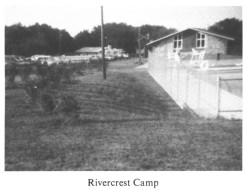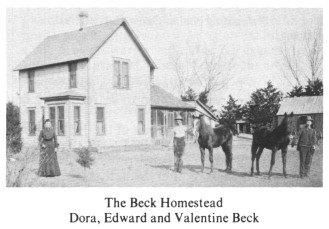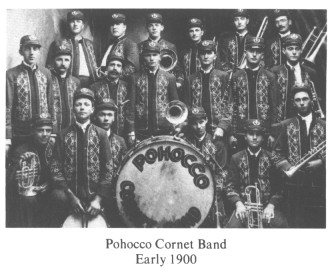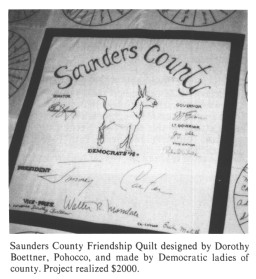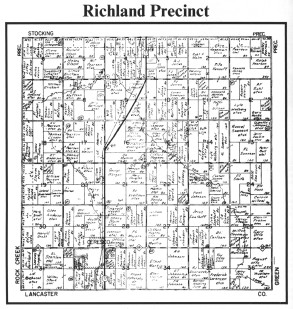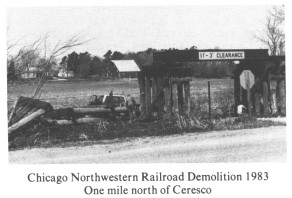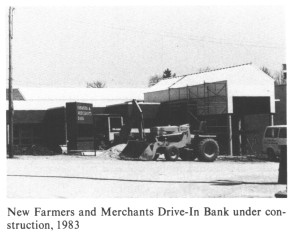 |
POHOCCO PRECINCT |
|
attached 2-story lodge, kitchen/dining hall, cabins and bath houses, caretaker's residence, steel maintenance building, 60-foot observation tower, and new swimming pool. The 1983 project is the building of the bath house for the pool.
Many, many people have donated money and labor towards the development of the camp, and the Lord continues to bless. Glenn Morrison of Fremont, Nebraska, has played a tremendous part in the selecting of a site, in much of the building, and in the development of the camp. For many years he also cared for the grounds. Later, Lu Vern Sawyer was very active as caretaker, treasurer and registrar. Present caretakers and registrar are Milo and Eleanor Stumbo and son, Todd.
GETTING OLDYou tell me I'm getting old; I tell you that's not so! THE POHOCCO CORNET BANDThe Pohocco Cornet Band, under the leadership of Del Juckett, was a leader in music entertainment and enjoyment in the early 1900's. They played for programs, and celebrations throughout the county. In 1906 they led the festivities for the dedication of the organization of the new town, Leshara. They marched in many parades, often times requesting that the children of District 11 or 105 join them.
|
|
W.J. Gibbs and J. Nelson located west of them. T.W. Riddle settled on Sec. 6 in the N.W. corner of the precinct and moved to Ceresco in 1870 and opened the first store in this section of the county. In 1870, a colony of Swedes located in the precinct and were followed shortly by a Mr. Miller at Lone Valley and the Fullsom brothers at Milton. Hiram Chub settled on sec. 23 at Bradford, in 1870, and Mr. Conkling at Rose Hill. Precinct Officers 1983-87: Chairman -- Edwin M. Hass, Clerk -- D. Ross Larson, Treas. -- Dwain Anderson.
HISTORY OF CERESCO 1869-1983Ceresco, Nebraska, is located on the southern edge of Saunders County just thirteen miles north of Lincoln. Its first settlers were Ashel and Horace Andrus, who came to the southern part of Saunders County in 1868. They settled in a section bordering the county line and one mile west of what is now Highway 77. Later Mr. and Mrs. Ira Nelson came and settled north of them. Mrs. Nelson was a sister of the Andrus brothers. The Andrus families came from the vicinity of Ceresco, Michigan, and chose to call their new town by that name. Although they probably named the town after their former home, they no doubt also had in mind the derivation of the name itself from Ceres, the mythological Roman Goddess of Grain and Fertility. The "co" was added to represent the company of settlers who were soon to follow them. The fertile land must have been impressive even then. The open, treeless prairie probably seemed stark to settlers who came from the east where forests predominated. James Henry Teachman, who came to Ceresco with his parents from New York, spent some of his early years transplanting trees from an Island in the Platte River to his home east of town. Land was available for sale around Ceresco in the late 1800's for $2.00 to $10.00 per acre from the Burlington Missouri River Railroad. Attractive land prices and a promise of a new life drew thousands of settlers westward. Ceresco grew as a trade center with the influx of home-steaders from the eastern United States and northern Europe. A great majority of the foreign settlers were first or second generation Swedes. In the early 1900's, Czech families settled in eastern Nebraska, some in the rural Ceresco area.
In 1869, a postoffice was established on the Ira Nelson farm with Ira Nelson as the first Postmaster. Later the Postoffice was moved to a farm whose ownership has been A.M. Haller, Sam Johnson, Sam Pearson, the Sward sisters, and Amos Sklenar. Horace Andrus was the Postmaster. The Postoffice was again moved to a part of the house now occupied by the Larry Stark family, one half mile south of the corner of the corner of 7th and Pine Streets. The first mail delivered in Ceresco was carried by Charles Whitney and was brought daily by horseback or stage. The stage horses were kept at the Ira Nelson farm, and the driver ate his meals there also. For this service the Nelsons received $12.00 a year. The Country was wide open, with few roads and bridges and mostly trails for horse and carriage travel. A daily stagecoach went from Lincoln (population 2,500) to Fremont in 1872. In December of that year, widespread disease among the horses in the area forced carriers to walk with the mail between the two cities. Horace Andrus, and later John Riddle, had a store in connection with the Ceresco Postoffice. Johannes and John Oberg operated a Blacksmith shop, and a Physician, Dr. Crickbaum, set up a practice in what is known as "old Ceresco." Religious activities were conducted by circuit riding ministers serving scattered groups of settlers. When the Fremont, Elkhorn, and Missouri Valley Railroad was to be built through the southeastern part of Nebraska, the tiny village of Ceresco apparently was overlooked. The rails were laid one mile to the east of the village, and it became necessary to move the town to the railroad. This was begun on June 10, 1886, when the Townsite Company bought from Louis Palman the original 160 acres of land for $3000 which is a part of where the town now stands. There was some contention as to where Main Street should be located when the town's streets were laid out. A prominent citizen named Yates wanted it to run east and west on the section line that passed his home. Others wanted it to go north and south where Ceresco's business section now stands. The house at 224 W. Main, just west of Immanuel Lutheran Church, was Yates' home. It was the only house on the town site then in what is now called Yates Addition to Ceresco. Mr. Yates' position prevailed and his street was named "Main Street." The town's main street did not develop there. Yates also attempted to persuade the railroad company to build the depot three blocks north of its present site, which would have put it close to his home. Officials did not consider it the proper place and the location of the railway station finally determined where the town's business section would develop. In the early years, six passenger trains came through Ceresco, three each way from Lincoln to Missouri Valley, Iowa. The first passenger train to pass through Ceresco was engineered by William W. Noyes in 1886. Engineer Noyes' son was a physician in Ceresco for a number of years and some of his descendants still live in the community. A.F. Reichle was Ceresco's first station agent. The Western Town-lot Co. set aside October 12, 1886, for the sale of lots, with the sale to remain open until 4 p.m. None were sold because people thought the prices were too high. After the closing hour, "Hod" Andrus on October 12 bought the first lot for $300 where the Farmers and Merchants Bank now stands, on the southwest corner of 2nd and Elm streets. He began building a store the next day which he called "The Pioneer Cheap Cash Store. Andrus resigned as postmaster to run his new business. Hod's brother Ashel bought the second lot just north of his brother's for $200 (now Ernie's Store) and built a hotel called "The Ceresco House." Other business places soon followed, until a list in Ceresco published 1887 numbered 30 businesses. John Oberg, who had Americanized his Swedish name of Jens Oberg, built a blacksmith shop in the new Ceresco and the town's first house. In 1886 two of his children were born. Mamie was born in old Ceresco, and Ernest William was born in December after the family had moved to new Ceresco. In 1968, Ernest rode in Ceresco's Centennial parade, honored as the new town's first baby.
May 10, 1895, is a memorable date in the history of Ceresco. About 4 a.m. the town was aroused by a wild cry of "fire." In spite of the heroic efforts of men and women alike, the entire business section was burned to the ground. It was a spectacular fire, driven by a strong northwest wind. Thirty buildings were destroyed. The fire originated in a building owned by Frank Ide with a saloon in it known as the "Hole In The Wall." It was located at N. 2nd and Beech Street. In spite of hard times with drought, wind, and grasshoppers, Ceresco was built a third time. Hod Andrus immediately rebuilt his store as a brick structure. About this time the saloon license was raised and Ceresco's saloonkeeper refused to pay it. In order to prevent the return of the saloon, men strictly opposed to it were placed on the Town Board. From the turn of the century to the present time, liquor has not been sold in Ceresco. Rural mail route No. 1 was established from the Ceresco Postoffice February 1, 1902, just three months after Rural Free Delivery was begun in Saunders County. William T. March was the first Carrier. A car dealership by Mr. and Mrs. Magnus Swanson offered the first Overland and Ford Automobiles in Ceresco in 1909. This business is the tenth oldest Ford dealership in continuous ownership in the United States and the oldest in Nebraska. About 1909, three or four men came to Ceresco one night to rob the old State Bank at 2nd and Elm streets. While they were getting ready to blow open the vault, one stood as lookout by the Livery Stable a little further west on Elm Street. Jim Boyle was returning home from a date that night, and aware that something was going on at the Bank, cut through the alley towards the Livery Stable. The "lookout" nabbed Boyle and brought him to the Bank. The men blew the vault, took about $400 and tied Jim Boyle to a chair where he spent the night. A Light and Water bond election, held December 8, 1914, brought approval for a plant put into operation on August 15, 1915. The original was $15,000. Later the plant was remodeled and changed to alternating current. In 1911, a Dr. Frank Wright moved to Ceresco and set up a medical practice. Dr. Wm. W. Noyes joined him in 1923. Dr. Wright moved to Lincoln in 1925 while Dr. Noyes remained to care for the sick. The Great Depression of the 1930's was felt in the village of Ceresco. In rural Saunders County dust bowl conditions and poor crop prices made it barely possible for the farmers to carry on. Businesses in
page 109 |
| Back | Contents | Next |
The Saunders County NEGenWeb Project
